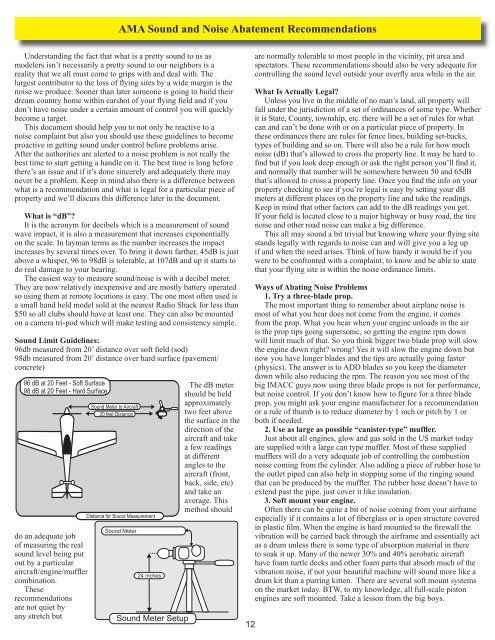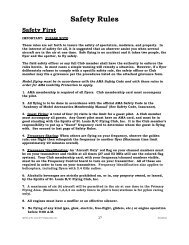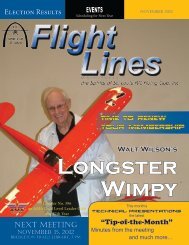Membership Manual - Spirits of St. Louis R/C Flying Club
Membership Manual - Spirits of St. Louis R/C Flying Club
Membership Manual - Spirits of St. Louis R/C Flying Club
You also want an ePaper? Increase the reach of your titles
YUMPU automatically turns print PDFs into web optimized ePapers that Google loves.
AMA Sound and Noise Abatement Recommendations<br />
Understanding the fact that what is a pretty sound to us as<br />
modelers isn’t necessarily a pretty sound to our neighbors is a<br />
reality that we all must come to grips with and deal with. The<br />
largest contributor to the loss <strong>of</strong> flying sites by a wide margin is the<br />
noise we produce. Sooner than later someone is going to build their<br />
dream country home within earshot <strong>of</strong> your flying field and if you<br />
don’t have noise under a certain amount <strong>of</strong> control you will quickly<br />
become a target.<br />
This document should help you to not only be reactive to a<br />
noise complaint but also you should use these guidelines to become<br />
proactive in getting sound under control before problems arise.<br />
After the authorities are alerted to a noise problem is not really the<br />
best time to start getting a handle on it. The best time is long before<br />
there’s an issue and if it’s done sincerely and adequately there may<br />
never be a problem. Keep in mind also there is a difference between<br />
what is a recommendation and what is legal for a particular piece <strong>of</strong><br />
property and we’ll discuss this difference later in the document.<br />
What is “dB”?<br />
It is the acronym for decibels which is a measurement <strong>of</strong> sound<br />
wave impact, it is also a measurement that increases exponentially<br />
on the scale. In layman terms as the number increases the impact<br />
increases by several times over. To bring it down farther, 45dB is just<br />
above a whisper, 96 to 98dB is tolerable, at 107dB and up it starts to<br />
do real damage to your hearing.<br />
The easiest way to measure sound/noise is with a decibel meter.<br />
They are now relatively inexpensive and are mostly battery operated<br />
so using them at remote locations is easy. The one most <strong>of</strong>ten used is<br />
a small hand held model sold at the nearest Radio Shack for less than<br />
$50 so all clubs should have at least one. They can also be mounted<br />
on a camera tri-pod which will make testing and consistency simple.<br />
Sound Limit Guidelines:<br />
96db measured from 20’ distance over s<strong>of</strong>t field (sod)<br />
98db measured from 20’ distance over hard surface (pavement/<br />
concrete)<br />
96 dB at 20 Feet - S<strong>of</strong>t Surface<br />
98 dB at 20 Feet - Hard Surface<br />
do an adequate job<br />
<strong>of</strong> measuring the real<br />
sound level being put<br />
out by a particular<br />
aircraft/engine/muffler<br />
combination.<br />
These<br />
recommendations<br />
are not quiet by<br />
any stretch but<br />
Sound Meter to Aircraft<br />
20 feet Distance<br />
Distance for Sound Measurement<br />
Sound Meter<br />
24 inches<br />
Sound Meter Setup<br />
The dB meter<br />
should be held<br />
approximately<br />
two feet above<br />
the surface in the<br />
direction <strong>of</strong> the<br />
aircraft and take<br />
a few readings<br />
at different<br />
angles to the<br />
aircraft (front,<br />
back, side, etc)<br />
and take an<br />
average. This<br />
method should<br />
12<br />
are normally tolerable to most people in the vicinity, pit area and<br />
spectators. These recommendations should also be very adequate for<br />
controlling the sound level outside your overfly area while in the air.<br />
What Is Actually Legal?<br />
Unless you live in the middle <strong>of</strong> no man’s land, all property will<br />
fall under the jurisdiction <strong>of</strong> a set <strong>of</strong> ordinances <strong>of</strong> some type. Whether<br />
it is <strong>St</strong>ate, County, township, etc. there will be a set <strong>of</strong> rules for what<br />
can and can’t be done with or on a particular piece <strong>of</strong> property. In<br />
these ordinances there are rules for fence lines, building set-backs,<br />
types <strong>of</strong> building and so on. There will also be a rule for how much<br />
noise (dB) that’s allowed to cross the property line. It may be hard to<br />
find but if you look deep enough or ask the right person you’ll find it,<br />
and normally that number will be somewhere between 50 and 65dB<br />
that’s allowed to cross a property line. Once you find the info on your<br />
property checking to see if you’re legal is easy by setting your dB<br />
meters at different places on the property line and take the readings.<br />
Keep in mind that other factors can add to the dB readings you get.<br />
If your field is located close to a major highway or busy road, the tire<br />
noise and other road noise can make a big difference.<br />
This all may sound a bit trivial but knowing where your flying site<br />
stands legally with regards to noise can and will give you a leg up<br />
if and when the need arises. Think <strong>of</strong> how handy it would be if you<br />
were to be confronted with a complaint, to know and be able to state<br />
that your flying site is within the noise ordinance limits.<br />
Ways <strong>of</strong> Abating Noise Problems<br />
1. Try a three-blade prop.<br />
The most important thing to remember about airplane noise is<br />
most <strong>of</strong> what you hear does not come from the engine, it comes<br />
from the prop. What you hear when your engine unloads in the air<br />
is the prop tips going supersonic, so getting the engine rpm down<br />
will limit much <strong>of</strong> that. So you think bigger two blade prop will slow<br />
the engine down right? wrong! Yes it will slow the engine down but<br />
now you have longer blades and the tips are actually going faster<br />
(physics). The answer is to ADD blades so you keep the diameter<br />
down while also reducing the rpm. The reason you see most <strong>of</strong> the<br />
big IMACC guys now using three blade props is not for performance,<br />
but noise control. If you don’t know how to figure for a three blade<br />
prop, you might ask your engine manufacturer for a recommendation<br />
or a rule <strong>of</strong> thumb is to reduce diameter by 1 inch or pitch by 1 or<br />
both if needed.<br />
2. Use as large as possible “canister-type” muffler.<br />
Just about all engines, glow and gas sold in the US market today<br />
are supplied with a large can type muffler. Most <strong>of</strong> these supplied<br />
mufflers will do a very adequate job <strong>of</strong> controlling the combustion<br />
noise coming from the cylinder. Also adding a piece <strong>of</strong> rubber hose to<br />
the outlet piped can also help in stopping some <strong>of</strong> the ringing sound<br />
that can be produced by the muffler. The rubber hose doesn’t have to<br />
extend past the pipe, just cover it like insulation.<br />
3. S<strong>of</strong>t mount your engine.<br />
Often there can be quite a bit <strong>of</strong> noise coming from your airframe<br />
especially if it contains a lot <strong>of</strong> fiberglass or is open structure covered<br />
in plastic film. When the engine is hard mounted to the firewall the<br />
vibration will be carried back through the airframe and essentially act<br />
as a drum unless there is some type <strong>of</strong> absorption material in there<br />
to soak it up. Many <strong>of</strong> the newer 30% and 40% aerobatic aircraft<br />
have foam turtle decks and other foam parts that absorb much <strong>of</strong> the<br />
vibration noise, if not your beautiful machine will sound more like a<br />
drum kit than a purring kitten. There are several s<strong>of</strong>t mount systems<br />
on the market today. BTW, to my knowledge, all full-scale piston<br />
engines are s<strong>of</strong>t mounted. Take a lesson from the big boys.








